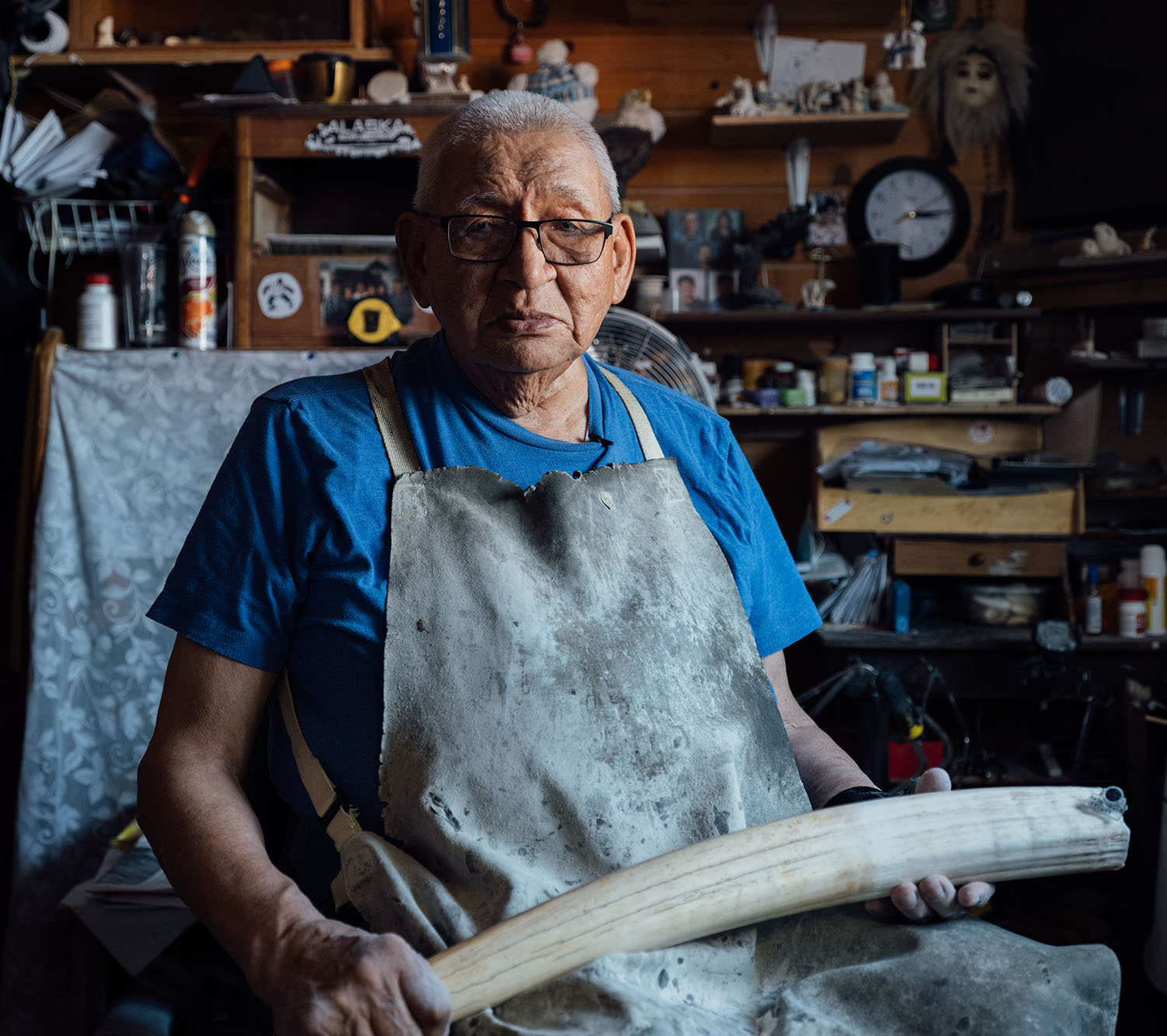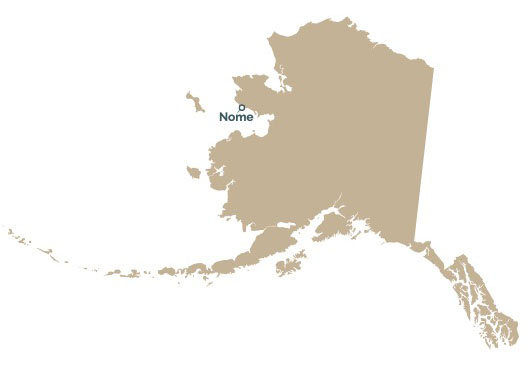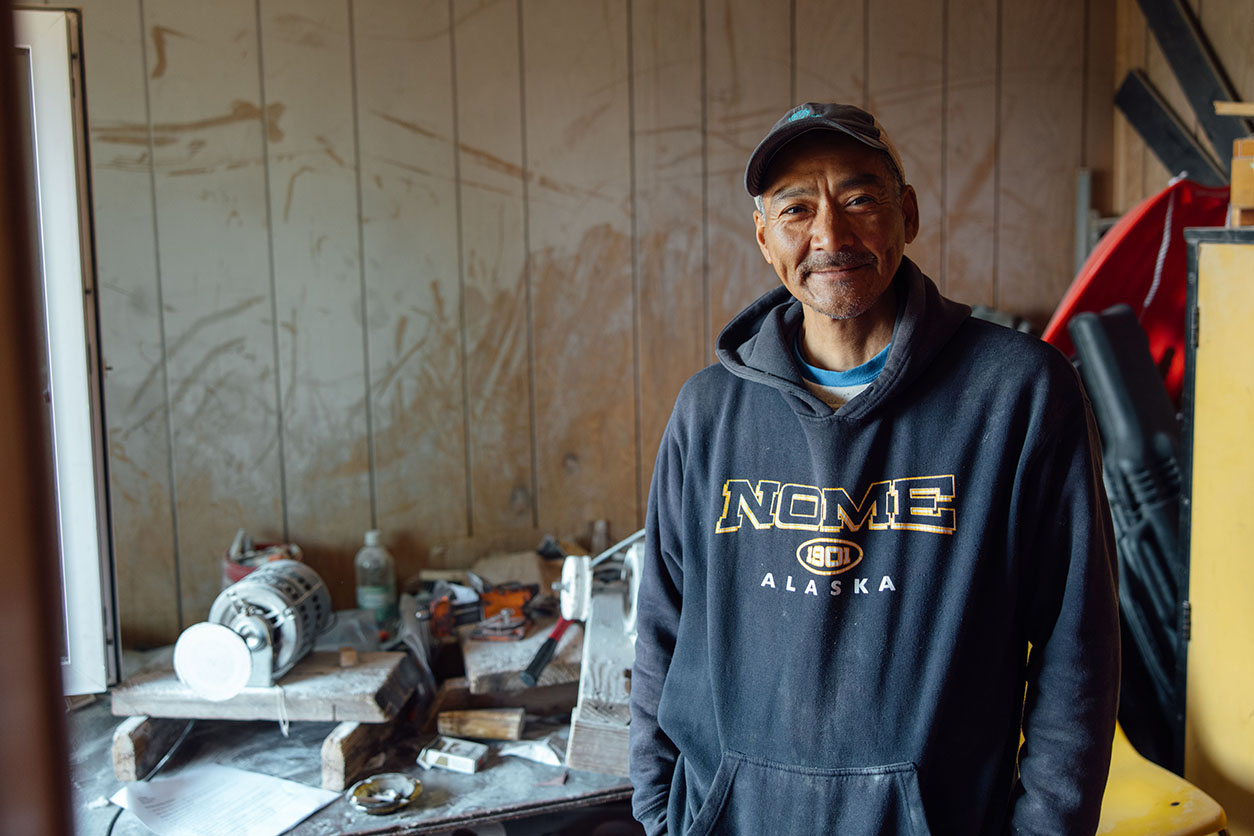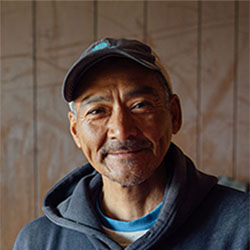Meet Ivory Artists
Artists who use walrus ivory are an example of the interconnectedness between Alaska Native culture, natural resources and economic viability. Meet Alaska Native ivory artists and hear their stories.
We invite you to come to Alaska and see first-hand the Alaska Native ways of life. Learn more about COVID-safe travel to the Last Frontier. If you would like to purchase walrus ivory artwork, visit Bering Strait Arts and Crafts Facebook group. Once there, enter “ivory” in the search bar.
Ben
Pungowiyi
Ben (Aghnatarma) Pungowiyi grew up in the village of Savoonga on St. Lawrence Island. He was raised by his grandfather who also was a carver. At the age of six, Ben carved his first piece of walrus ivory – a seal that took about a week to complete. The seal was later sold at the market, giving Ben a great sense of pride that he produced something to help support his family. Ben has gone on to become a master carver, using hand tools as well as motorized tools to create intricate carvings that tell the story of his Native heritage and way of life.
Ben currently lives in Savoonga where he is a special education aide in the Bering Straits School District and a Village of Savoonga tribal leader.

Ben
Pungowiyi
Ben (Aghnatarma) Pungowiyi grew up in the village of Savoonga on St. Lawrence Island. He was raised by his grandfather who also was a carver. At the age of six, Ben carved his first piece of walrus ivory – a seal that took about a week to complete. The seal was later sold at the market, giving Ben a great sense of pride that he produced something to help support his family. Ben has gone on to become a master carver, using hand tools as well as motorized tools to create intricate carvings that tell the story of his Native heritage and way of life.
Ben currently lives in Savoonga where he is a special education aide in the Bering Straits School District and a Village of Savoonga tribal leader.

Joe
Kunnuk
Originally born in King Island, Joe (Anatuq) Kunnuk moved 90 miles southeast to Nome in 1956 where he continues to live today. When he was nine or 10 years old, Joe’s dad gave him a walrus tooth and a file, and said it was time to learn how to carve. Rather than receiving lessons, Joe learned his skills by watching others. His first carving was a polar bear made of walrus ivory. Joe grew up using carvings to pay for his family’s groceries and bills. It was such a customary tradition that he hadn’t seen cash until he was a teenager.
Joe takes great pride in walrus harvest and hopes carving can continue for many generations to come.

Joe
Kunnuk
Originally born in King Island, Joe (Anatuq) Kunnuk moved 90 miles southeast to Nome in 1956 where he continues to live today. When he was nine or 10 years old, Joe’s dad gave him a walrus tooth and a file, and said it was time to learn how to carve. Rather than receiving lessons, Joe learned his skills by watching others. His first carving was a polar bear made of walrus ivory. Joe grew up using carvings to pay for his family’s groceries and bills. It was such a customary tradition that he hadn’t seen cash until he was a teenager.
Joe takes great pride in walrus harvest and hopes carving can continue for many generations to come.

Ralph
Olanna
Ralph Olanna comes from a family of walrus ivory artists. His handicraft focuses on beadwork and jewelry. His favorite tools used in his beadwork include a washing maching motor and a piece of wood with a nail embedded in it – tools he says are necessary to shape the beads. In Ralph’s village of Shishmaref, many of his neighbors make their income from selling their artistic carvings and jewelry. If states continue banning walrus ivory – which is legally sold by Alaska Natives – he fears many will no longer be able to financially support and feed their families.

Ralph
Olanna
Ralph Olanna comes from a family of walrus ivory artists. His handicraft focuses on beadwork and jewelry. His favorite tools used in his beadwork include a washing maching motor and a piece of wood with a nail embedded in it – tools he says are necessary to shape the beads. In Ralph’s village of Shishmaref, many of his neighbors make their income from selling their artistic carvings and jewelry. If states continue banning walrus ivory – which is legally sold by Alaska Natives – he fears many will no longer be able to financially support and feed their families.

Daryl
Kingeekuk
Daryl Kingeekuk loves his life in Savoonga and the traditional lifestyle found on St. Lawrence Island in northwestern Alaska. Growing up, he learned a lot through experience and by watching others. Daryl appreciates that his community works as one together, similar to the proverb, “It takes a village to raise a child.” His first whale harvest was around the age of five or six with his older brother. They were successful and his brother said Daryl was good luck. That same brother encouraged him to try carving, like their father who Daryl said could make carvings look real. In Daryl’s own work, he specializes in scrimshaw and enjoys making hunting scenes. He creates separate carvings with the same scene and then puts them together as one. For Daryl, walrus is life and gives life.

Daryl
Kingeekuk
Daryl Kingeekuk loves his life in Savoonga and the traditional lifestyle found on St. Lawrence Island in northwestern Alaska. Growing up, he learned a lot through experience and by watching others. Daryl appreciates that his community works as one together, similar to the proverb, “It takes a village to raise a child.” His first whale harvest was around the age of five or six with his older brother. They were successful and his brother said Daryl was good luck. That same brother encouraged him to try carving, like their father who Daryl said could make carvings look real. In Daryl’s own work, he specializes in scrimshaw and enjoys making hunting scenes. He creates separate carvings with the same scene and then puts them together as one. For Daryl, walrus is life and gives life.

Stanley and Travis
Tocktoo
Stanley (Atiitiga Qawiagraq) Tocktoo was born and raised in Shishmaref. His first memory of ivory carving was watching his grandpa work on mastodon ivory to create jewelry. He wonders how his ancestors, thousands of years ago, were able to cut ivory straight in half without any kind of handsaw or leaving sawing/cutting marks in the ivory.
Travis (Qaigruk) Tocktoo is originally from Brevig Mission and now lives in Shishmaref. As a child, he watched is uncle carve a polar bear and wanted it to do it some day. Travis still remembers the smell from the carving room, it was unique and exiting. When someone is amazed by his work or is successful because of the tools he carved, Travis is inspired to do more and further perfect his craft.
The two appreciate how the village and Mother Nature allow them to sustain themselves all four seasons. Their respect for the land and sea, supports their traditions, values and culture.

Stanley and Travis
Tocktoo
Travis (Qaigruk) Tocktoo is originally from Brevig Mission and now lives in Shishmaref. As a child, he watched is uncle carve a polar bear and wanted it to do it some day. Travis still remembers the smell from the carving room, it was unique and exiting. When someone is amazed by his work or is successful because of the tools he carved, Travis is inspired to do more and further perfect his craft.
The two appreciate how the village and Mother Nature allow them to sustain themselves all four seasons. Their respect for the land and sea, supports their traditions, values and culture.

Hannah
Alowa
Born and raised in Nome, Alaska, Hannah (Asaapuk Mukuluk) Alowa ow calls Anchorage, Alaska her home. She carved her first walrus figurine when she was 10-11 years old after watching her granddad. Despite his health issues, Hannah’s granddad continued to carve. She thought it was beautiful to watch someone put in the hard effort while loving what they do. Hannah turned carving from a hobby into a business a couple of years ago. Living in Anchorage helps her keep her shipping costs down for people buying her work. However, she believes there is much more to carving ivory than profit – there’s a real connection to it. Hannah inherited many pieces of ivory from her granddad after he passed. She wishes she could show him what she is doing with his pieces and how she is committed to not letting his styles fade away.
View Hannah’s Art

Hannah
Alowa
Born and raised in Nome, Alaska, Hannah (Asaapuk Mukuluk) Alowa ow calls Anchorage, Alaska her home. She carved her first walrus figurine when she was 10-11 years old after watching her granddad. Despite his health issues, Hannah’s granddad continued to carve. She thought it was beautiful to watch someone put in the hard effort while loving what they do. Hannah turned carving from a hobby into a business a couple of years ago. Living in Anchorage helps her keep her shipping costs down for people buying her work. However, she believes there is much more to carving ivory than profit – there’s a real connection to it. Hannah inherited many pieces of ivory from her granddad after he passed. She wishes she could show him what she is doing with his pieces and how she is committed to not letting his styles fade away.
View Hannah’s Art

Promoting Authentic Art
The U.S. Department of the Interior, Indian Arts and Crafts Board (IACB), developed this brochure to promote the creative work of Alaska Native artists and artisans.







